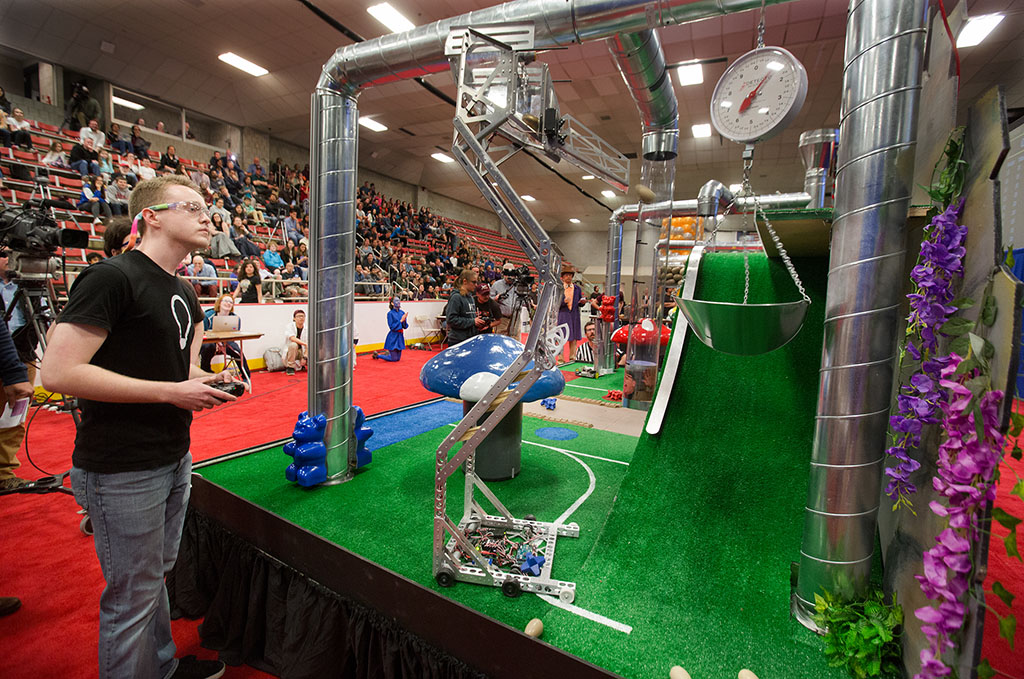Students demonstrate "calculated imagination" in robot competition
On Thursday evening, the Johnson Ice Rink was transformed into a world of pure imagination. Students taking 2.007 (Design and Manufacturing I) showcased their own imaginative designs in the class’ final robot competition. This year’s Willy Wonka-themed competition featured a colorful game board based on the famous Chocolate Room and two equally colorful emcees: course instructors Sangbae Kim, donning a purple velvet coat as Willy Wonka, and Amos Winter, dressed as Charlie Bucket (complete with golden ticket).
“We’re all engineers; we can do better than pure imagination,” said Winter as he kicked off the event. “We can do calculated imagination!” Thirty-two student finalists showed just how calculated their imagination could be in five sudden-death rounds throughout the event.
In each round, two students went head-to-head to gain the most points. Their robots navigated two massive game boards to achieve certain tasks such as lifting gummy bears, pushing Gobstoppers into a river of chocolate, and freeing Oompa Loompas from pipes. In one task, students were scored based on how much kinetic energy they could put into a spinning mushroom.
The game board was designed to get students familiar with basic mechanical engineering principles. In building their robots, students gained an understanding of concepts such as traction, gripper design, sensor integration, autonomy, and optimized motor power.
“Each task is specifically designed to guide students to apply fundamental mechanics knowledge to their own design executions and help them to understand the important concepts through the design process,” says Kim, who is an associate professor of mechanical engineering.
The students design robots of all shapes and sizes with a multitude of capabilities. “The diversity in robots reflects the diversity in our students,” explains Winter, an associate professor of mechanical engineering. “Each one is different and shows unique elements of their creators’ personalities.”
Some robots were small, simple and compact, such as Feliciano Escobedo’s robot, "Mushu." Other robots, like John Taylor Novak’s "Red Eye," tipped the scales at nearly 12 pounds (the competition limit) and could extend several feet tall.
“Each student runs their own robot during the competition, so they have the chance to show off their work in front of their friends,” says Winter.
The competition has become a seminal event in MIT’s academic calendar. Spearheaded by Professor Emeritus Woodie Flowers in the 1970s, the competition gives mechanical engineering students an opportunity to gain hands-on experience in designing and building. Students can only use the materials given to them at the beginning of the semester. “You saw a lot of fancy mechanisms tonight but it all starts with raw scrap materials like aluminum and plastic,” says Kim.
A crowd filled with fellow students, faculty, and other members of the MIT community cheered as the 32 students were whittled down to the final two: Erika Mynio and Mason Massie, both mechanical engineering sophomores. In the end, Massie emerged victorious.
“Honestly, I wasn’t expecting to win at all,” says Massie. “When it got down to it and I started to realize maybe things were turning in my favor, I just tried to keep a cool head.”
Massie’s winning design featured two robots — a small autonomous robot called "Oompa Raiser" and a larger scissor-lift robot called "Do You Even Lift, Bro?" For the larger robot, Massie made his own custom omnidirectional wheels to navigate the gameboard’s tight spaces.
As a member of MIT’s Combat Robotics Club, Massie has had experience in robot competitions. He and his fellow teammates from MIT will be featured on an upcoming episode of the Discovery Channel’s show, "Battlebots." The key to his success on Thursday night, according to Massie, was spending lots of time on a computer using CAD to make sure his robot would work, before he spent countless hours building it.
For Massie, the best part of 2.007 was the spirit of collaboration and knowledge sharing with his fellow students. “Lab was a lot of fun because you would talk to people about their designs and you would give each other pointers,” Massie adds.
While Massie may have walked away the victor of Thursday night’s competition, all 165 students could celebrate the fact that they built their own robot, even if it did not operate as they had hoped. “For many of our students, it’s their first experience designing something on their own,” explains Winter.
Win or lose, each student emerged from the competition armed with more knowledge of basic mechanical engineering principles along with a tangible representation of both what they learned this semester and their own "calculated imagination": a robot they built themselves from scratch.

